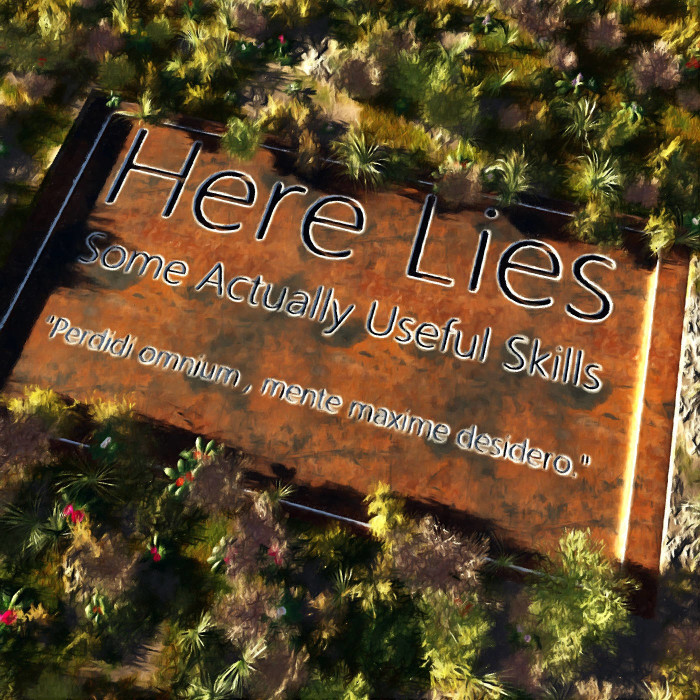Of all the things I’ve lost, I miss my mind the most.
Please Remember:
The opinions expressed are mine only. These opinions do not necessarily reflect anybody else’s opinions. I do not own, operate, manage, or represent any band, venue, or company that I talk about, unless explicitly noted.

 Want to use this image for something else? Great! Click it for the link to a high-res or resolution-independent version.
Want to use this image for something else? Great! Click it for the link to a high-res or resolution-independent version.Big Blue Ox was on the stage for soundcheck, and there was a bit of a problem. Because I get so much drum bleed through the vocal mics at my regular gig, I’ve given up on using overheads or hi-hat mics. The issue with this was that Big Blue Ox plays with some pretty gnarly timing swings, and they need the hat to help them count.
Up on stage I went with a “pencil” condenser, ready to unleash one of my favorite tricks. When space and time is limited, I use gaffers tape to mount a mic on the hat stand, with the mic pointing up at the bottom hat. With everything in place, I trotted back to the console. The input that I expected the mic to be on was dead, but I was seeing a bit of action on the next input over. “I must be off by one on my patch,” I thought.
I won’t go into everything else that followed. Suffice it to say that the mic was repositioned, cables were swapped, and a snake line was ultimately bypassed…
…and then, I finally realized my mistake.
Months earlier, I had deactivated the phantom power on the final bank of inputs to my mix rig. I don’t use ribbon mics, and I make it a point to use DI boxes for getting line-level inputs into the PA, so I’m used to the idea of just having phantom applied to everything. (It saves me from having to check if it’s needed for a particular line. I just plug in and go.) My shutting down the phantom on the final few inputs wasn’t a problem originally, because those inputs are usually a handful of dynamic mics for drums. Also, that removal of phantom was an anomaly.
An anomaly I no longer thought to check for, because – as I said – I always have phantom applied to everything. It makes my life easier about 99% of the time.
My “check for phantom” skill had perished, and the result was a comedy of errors. It did finally dawn on me that phantom might not be engaged, and we did eventually get hi-hat in the wedges. Personally, I think it was all pretty danged funny.
But it’s still important for me to recognize that the skill had withered on the vine.
Use It Or Lose It
I was first introduced to the phrase “perishable skill” through the series “Carrier.” (It’s that documentary about the USS Nimitz.) As the ship is underway back to the US, a situation occurs where the flight deck is pitching dramatically. This is used as an opportunity to provide some continuing-education to the naval aviators aboard the boat. The captain states something to the effect of “Landing on an aircraft carrier is a perishable skill.”
As it turns out, there’s plenty involved with show production that’s also a perishable skill.
The competencies that tend to drift to the wayside are the little things. The routine practices that escape conscious thought. Especially prone to quiet death are the bits that get “automated.” Automation can take the form of tasks that are actively executed for you, but it can also show up when a process becomes passively implemented. For instance, my choice to just leave phantom applied to every line entering the console. Pressing the phantom switches isn’t something that I’ve created a robot to do, or a process that requires some sort of scripted action. Once pressed, the buttons stay that way. I just assume that the phantom is on. It’s a passive implementation.
I’m the same way about the patching of physical lines to the console. Barring an equipment failure, input 1 on the snake is input 1 at the console, all the way down the line to however many inputs are in play. I never think to check for physical crosspatching, because I prefer to avoid it. This once bit me VERY hard at a show I did in Ogden on an unfamiliar audio rig…
Anyway.
The point is that a skill unused, especially one that’s “small” or routine, will tend to atrophy. I’m not here to rant and rave about having a refresher for every little thing, because I’m not going to do that – and you probably won’t either. Instead, I think it’s just wise to understand that our production routines tend to create blind spots. Complacency, and all that. Getting into a groove is a great thing, but whatever is outside that groove can easily escape from us. If we keep in mind that skills are perishable, and that our choices of what to push away from conscious management determine what perishes, we can be ready when the unexpected occurs. We can ask ourselves what might have gone wrong that’s not part of our usual workflow, and troubleshoot accordingly.